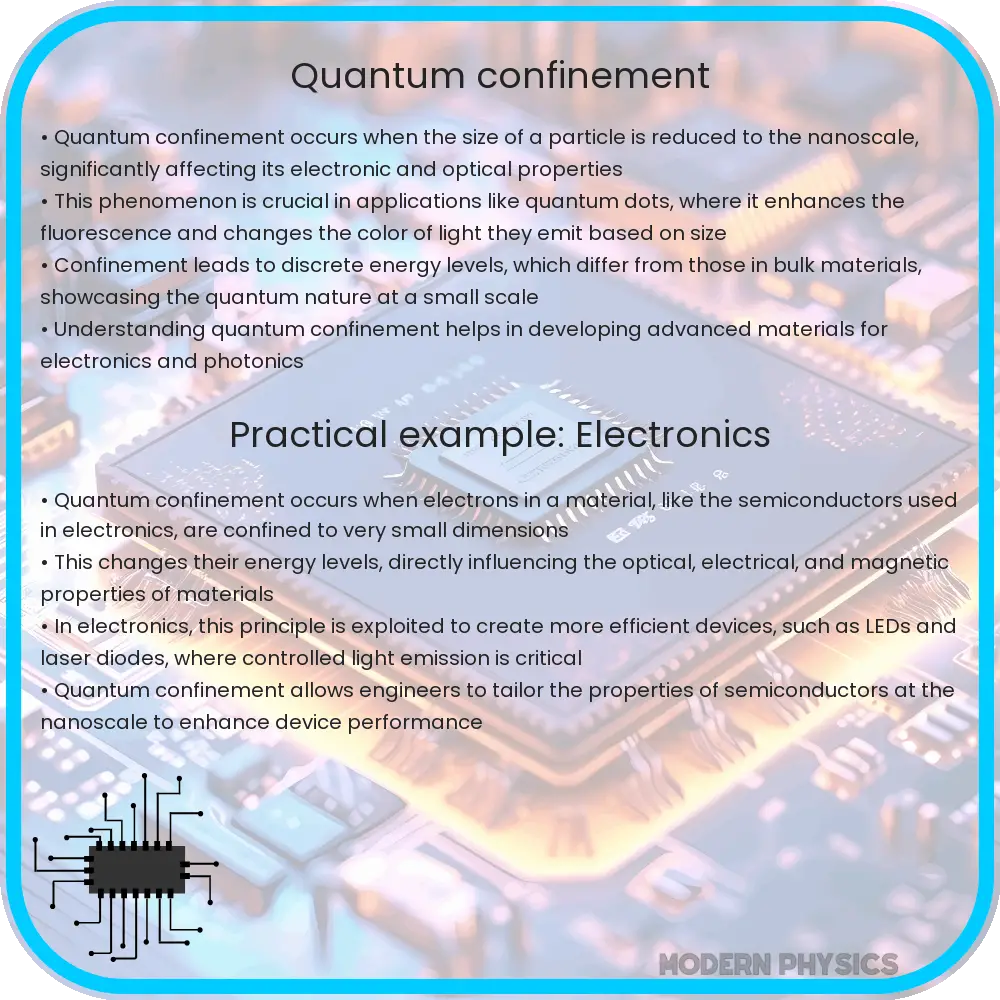Quantum confinement is a phenomenon affecting particle properties at nanoscale, crucial for advancing electronics and photonics.

Introduction to Quantum Confinement
At the forefront of modern physics and material science is a peculiar phenomenon known as quantum confinement. This effect plays a pivotal role in determining the electrical and optical properties of materials at the quantum scale. It becomes relevant in materials whose dimensions are comparable to the de Broglie wavelength of the electrons within them, often visible in nanoscale structures like quantum dots, nanowires, and thin films.
Understanding Quantum Confinement
Quantum confinement arises when the motion of particles, such as electrons, is restricted to a small “confined” space. This confinement significantly alters the energy levels of the particles. To understand this, consider the particles as being similar to waves. When these wave-like particles are confined, their wavelengths are restricted to certain values, leading to quantized energy levels.
In physics, the size of the confining structure can be so small that it approaches the particle’s de Broglie wavelength, typically at the nanometer scale (a nanometer is one billionth of a meter). At such scales, classical physics no longer adequately describes the behavior of particles. Instead, quantum mechanics provides the tools to understand and predict the particle properties.
Types of Quantum Confinement
- Zero-dimensional (0D) Confinement: Occurs in quantum dots where electrons are confined in all three spatial dimensions. This leads to discrete energy states, much like individual atoms.
- One-dimensional (1D) Confinement: Found in nanowires or quantum wires where electrons can move freely in one dimension but are confined in the other two, thus altering their quantum states.
- Two-dimensional (2D) Confinement: Observed in quantum wells where electrons are free to move in two dimensions but confined in one. This configuration is common in heterostructures used in semiconductor lasers.
Each type of confinement affects the electronic and optical properties differently, which is crucial for designing devices at the nanoscale.
Quantum Confinement in Practical Applications
One of the most exciting aspects of quantum confinement is its impact on the optical properties of materials. Quantum dots, for example, can emit light at different wavelengths depending on their size due to quantum confinement effects. This property is harnessed in applications ranging from quantum computing to medical imaging, where specific wavelength emissions are crucial.
In semiconductors, quantum confinement can alter the material’s absorption and emission spectra. This principle is exploited in designing new types of solar cells and transistors that are more efficient than their bulk counterparts. Engineers can tweak the size and shape of the nanostructures to tailor the electrical and optical responses of these materials for specific applications.
Moreover, the enhanced performance of lasers, LEDs, and other optoelectronic devices can often be attributed to quantum confinement, which allows for better control over electron movement and light emission.
Challenges and Opportunities
While the benefits of quantum confinement in nanotechnology and electronics are significant, there are also considerable challenges. Precise control over the size, shape, and uniformity of nanomaterials is necessary to fully utilize the advantages offered by quantum confinement. Additionally, the integration of these nanostructures into existing technology poses engineering challenges.
Despite these hurdles, the exploration of quantum confined systems continues to offer innovative pathways in technology development, pushing the boundaries of what’s possible in electronics, photonics, and beyond.
Future Prospects in Quantum Confinement
Looking ahead, the future of quantum confinement in technology development holds immense promise. As research progresses, the potential to further miniaturize electronic devices while enhancing their efficiency and performance is significant. Continued innovation in material science could lead to breakthroughs in how quantum confinement is applied, especially in computing and telecommunications.
Furthermore, the integration of quantum confined materials into everyday technology could revolutionize the consumer electronics market, offering devices with improved functionalities, higher speeds, and lower energy consumption. There is also potential for significant advancements in non-electronic applications such as biochemical sensors and environmental monitoring systems, where the sensitivity and selectivity of materials enhanced by quantum confinement could be pivotal.
Environmental and Safety Considerations
As we embrace the advantages of quantum confinement, it’s also crucial to consider the environmental and safety implications of nanotechnology. The production, use, and disposal of nanomaterials could pose new challenges, necessitating thorough studies and the development of appropriate safety protocols. Ensuring that these materials are environmentally benign and posing minimal health risks to both humans and wildlife will be essential for sustainable advancement.
Conclusion
Quantum confinement represents a striking illustration of how quantum mechanics influences material properties and open new horizons in science and technology. The unique phenomena associated with confined quantum systems provide a platform for innovation across multiple fields, from next-generation electronics and photonics to renewable energy and beyond. Despite the challenges, the continued exploration and application of quantum confinement principles signal a transformative trajectory in modern material science and engineering. As we move forward, the convergence of interdisciplinary research efforts will be key in unlocking the full potential of these fascinating quantum effects for practical and groundbreaking uses.
